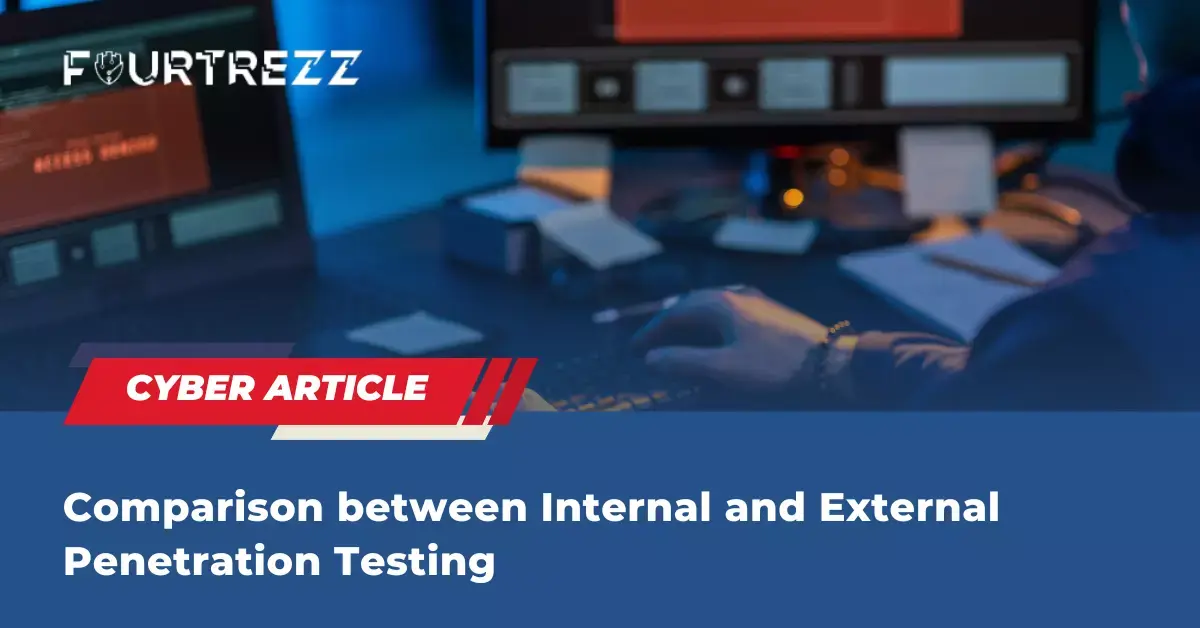Jumat, 15 September 2023 | 9 min read | Andhika R
Comparison between Internal and External Penetration Testing
Penetration Testing, also known as ethical hacking, is the practice of checking the security weaknesses of a software application, network, computer, device, wireless system, and employees. Penetration Testing can be external or internal depending on the project's objective.
External Penetration Testing researches and attempts to exploit vulnerabilities that can be performed by external users without appropriate access and permission. Meanwhile, Internal Penetration Testing is similar to vulnerability assessment; however, it takes scanning a step further by trying to exploit vulnerabilities and determining what information is actually exposed.
On this occasion, Fourtrezz will discuss the comparison between internal and external Penetration Testing. These two types of tests have different objectives and methodologies, so it is important to understand their differences to choose the right type according to your organization or business needs.

External Penetration Testing
External Penetration Testing is a type of testing aimed at evaluating system security by trying to exploit vulnerabilities that can be performed by external users without appropriate access and permission. This testing has the same objective as simulating attacks on the internal network, where the Pentester will try to mimic the actions of a real hacker. This testing aims to find and exploit system vulnerabilities to steal or damage company information. As a result, this testing will show whether the security measures taken are sufficient to secure the company and evaluate the company's ability to defend itself against any external attacks.
Main Goals and Objectives
As explained above, the main goal of external Penetration Testing is to evaluate system security by trying to exploit vulnerabilities that can be performed by external users without appropriate access and permission. This goal is the same as simulating attacks on the internal network, where the tester will try to mimic the actions of a real threat actor.
The main objectives of external Penetration Testing are:
- Finding system vulnerabilities accessible by external users
- Exploiting these vulnerabilities to determine what information is exposed to outsiders
- Assessing the system's ability to defend itself against external attacks
- Providing security recommendations to strengthen the system against future external attacks.
Examples and Methodologies of External Penetration Testing
Here are some examples and methodologies used in External Penetration Testing:
Examples of External Penetration Testing:
- Configuration & Deployment Management Testing: Testing vulnerabilities related to system configuration and management
- Identity Management Testing: Testing vulnerabilities related to user identity management
- Authentication Testing: Testing vulnerabilities related to the user identity verification process
- Authorization Testing: Testing vulnerabilities related to granting access and user rights
- Session Management Testing: Testing vulnerabilities related to user session management
- Input Validation Testing: Testing vulnerabilities related to the validation of inputs received by the system
- Testing for weak Cryptography: Testing vulnerabilities related to the strength and security of the cryptography algorithms used
Methodologies of External Penetration Testing:
- Footprinting: A technique used to gather public information about an organization or system. This information can include details found on the organization's website, social media profiles, domain information, and more. The goal is to collect information that can be used to exploit system vulnerabilities.
- Checking for public information and other information leakages: A technique used to search for public information that can be used to exploit system vulnerabilities. This information can include details found on the organization's website, social media profiles, domain information, and more.
- System Scanning/Port Scanning/Service Scanning for vulnerabilities: Techniques used to find vulnerabilities in the system, ports, or services available. System scanning is done using tools that scan all open ports on the system to be tested. Once open ports are found, the tester will try to exploit the vulnerabilities present in those ports.
- Manual testing identified vulnerabilities: A technique used to exploit vulnerabilities identified manually. After vulnerabilities are identified through previous methodologies, the tester will try to exploit them manually by looking for gaps or vulnerabilities in the system to be tested.
- IDS/IPS Testing: A technique used to test vulnerabilities related to Intrusion Detection and Prevention Systems (IDS/IPS). IDS/IPS are systems used to detect ongoing or attempted attacks on the protected system.
- Password Strength Testing: A technique used to test the strength of passwords used on the system to be tested. The tester will try to find weak or easily guessable passwords by exploiting password vulnerabilities using techniques such as brute force or dictionary attacks.
Read Also: Some Pentest Tools Used by Ethical Hackers
Internal Penetration Testing
Internal Penetration Testing is a type of testing that uses different methods from external Penetration Testing in handling attacks. This testing is conducted after external Penetration Testing is completed to ensure that the company's system is secure from both external and internal attacks.
This testing is not only limited to exploiting internal network vulnerabilities but also includes other destructive actions such as extended access rights, malware dissemination, man-in-the-middle (MITM) attacks, credential theft, monitoring, and information leakage. This testing is necessary to assess the security of the company's internal system and identify potential vulnerabilities from internal access.
Main Goals and Objectives
The main goal of internal Penetration Testing is to assess the security of the company's internal system and identify potential vulnerabilities from internal access. The main objective of this testing is to measure the company's system's ability to protect itself from internal attacks and find out what an attacker with internal access to the company's network can do.
Internal Penetration Testing also aims to provide recommendations to the company regarding preventive measures and security enhancements that can be taken to avoid future internal attacks. This testing can also help the company assess the effectiveness of the security measures already taken, as well as provide an evaluation of the company's ability to handle internal attacks.
Examples and Methodologies of Internal Penetration Testing
Here are some examples and methodologies used in Internal Penetration Testing:
Examples of Internal Penetration Testing:
- Computer Systems: The tester will try to exploit vulnerabilities in the company's computer systems, such as operating systems, application software, and hardware.
- Access Points: The tester will try to exploit vulnerabilities in access points or wireless routers connected to the company network.
- WiFi Networks: The tester will try to exploit vulnerabilities in the company's WiFi networks, including vulnerabilities in authentication and encryption systems.
- Firewalls: The tester will try to exploit vulnerabilities in the company's firewalls, including vulnerabilities in firewall configuration and implementation.
- IDS/IPS: The tester will try to exploit vulnerabilities in the Intrusion Detection and Protection Systems (IDS/IPS) used by the company.
- Local Servers: The tester will try to exploit vulnerabilities in the company's local servers, including vulnerabilities in operating systems, application software, and hardware.
- Employees: The tester will try to exploit vulnerabilities related to the actions and habits of company employees, including vulnerabilities in weak passwords or unsafe use of mobile devices.
Methodologies of Internal Penetration Testing:
- Footprinting: The Pentester will look for publicly available information about the company network, including information about network infrastructure, operating systems, and applications used.
- System Scanning/Port Scanning/Service Scanning: The Pentester will look for vulnerabilities by scanning the network, ports, or services connected to the company network.
- Manual Testing: The Pentester will manually exploit identified vulnerabilities using available tools and techniques.
- IDS/IPS Testing: The Pentester will try to exploit vulnerabilities in the Intrusion Detection and Protection Systems (IDS/IPS) used by the company.
- Password Strength Testing: The Pentester will try to exploit vulnerabilities in weak or unsafe passwords used by company employees.
Comparison between Internal and External Penetration Testing
There are several main differences between internal and external Penetration Testing, namely:
- Main Goals and Objectives: The main goal of external Penetration Testing is to assess the security of the company's external system and identify potential vulnerabilities from external access. Meanwhile, the main goal of internal Penetration Testing is to assess the security of the company's internal system and identify potential vulnerabilities from internal access.
- Testing Scope: The scope of external Penetration Testing is limited to the company's external network, while the scope of internal Penetration Testing includes both the company's internal and external networks.
- Testing Methodology: The testing methodology used in external Penetration Testing focuses more on finding vulnerabilities related to the company's external network, while the methodology used in internal Penetration Testing focuses more on finding vulnerabilities related to the company's internal network.
- Required Time: External Penetration Testing generally takes longer than internal Penetration Testing. This is because external Penetration Testing covers a wider external network, requiring more time to find and exploit vulnerabilities. Meanwhile, internal Penetration Testing only covers the internal network, requiring less time to find and exploit vulnerabilities.
- Access Level: External Penetration Testing only has access to the company's external network, while internal Penetration Testing has full access to the company's internal network.
- Test Focus: External Penetration Testing focuses more on finding vulnerabilities related to the company's external network, while internal Penetration Testing focuses more on finding vulnerabilities related to the company's internal network.
- Test Impact: The impact of external Penetration Testing is limited to the company's external network, while the impact of internal Penetration Testing can occur throughout the entire company's internal network.
- Security Level: External Penetration Testing is considered to have a lower security level compared to internal Penetration Testing because the tester only has access to the company's external network and does not have full access to the internal network. Meanwhile, internal Penetration Testing is considered to have a higher security level because the tester has full access to the company's internal network.
Conclusion
Penetration Testing is an effective method to assess the security of a company's network and identify potential vulnerabilities. Penetration Testing can be conducted both internally and externally, depending on the goals and objectives to be achieved. Both internal and external Penetration Testing are very important for organizations, as they can help identify potential vulnerabilities and help improve the security level of the company's network.
Therefore, companies looking to enhance their network security level should seriously consider Penetration Testing services. With Penetration Testing services, companies can ensure that their network is secure and not vulnerable to both internal and external attacks. If you are interested in Penetration Testing services, do not hesitate to contact Fourtrezz to help enhance your company's network security level.
Andhika RDigital Marketing at Fourtrezz
Artikel Terpopuler
Tags: Remediasi Risiko, Mitigasi Pasca-Pentest, Prioritas CVSS, Keamanan Siber, Manajemen Kerentanan
Baca SelengkapnyaBerita Teratas
Berlangganan Newsletter FOURTREZZ
Jadilah yang pertama tahu mengenai artikel baru, produk, event, dan promosi.



